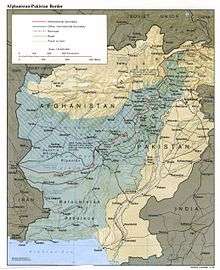துராந்து எல்லைக்கோடு
துராந்து எல்லைக்கோடு (Durand Line (பஷ்தூ: د ډیورنډ کرښه) ஆப்கானித்தான் மற்றும் பாகிஸ்தான் நாடுகளை பிரிக்கும் 2430 கிமீ நீளம் கொண்ட பன்னாட்டு எல்லைக் கோடாகும். 1878–1880ல் நடைபெற்ற இரண்டாம் ஆங்கிலேய ஆப்கானியப் போருக்குப் பின்னர்

இந்த எல்லைக்கோடு முதலில் 1896ல் பிரித்தானிய புவியியல் அறிஞரான் சர் மோர்டிமர் துராந்து என்பவரால் வரையறுக்கப்பட்டதால், இந்த எல்லைக்கோட்டிற்கு துராந்து எல்லைக்கோடு எனப்பெயராயிற்று.
12 நவம்பர் 1893ல் பிரித்தானிய இந்தியா அரசும் மற்றும் ஆப்கானிய அமீர் அப்துர் ரக்மானும் செய்து கொண்ட கந்தமாக் உடன்படிக்கையின் படி துராந்து எல்லைக்கோட்டை இருதரப்பினரும் ஏற்றுக்கொண்டனர்.
துராந்து எல்லைக்கோடு வரையறுத்தப் பின்னர் ஆப்கானித்தான் தன்னாட்சியுடன் ஆட்சி செய்தாலும், அதன் வெளியுறவு விவகாரங்களை பிரித்தானிய இந்திய அரசே நிர்வகித்தது.[1][2][3] துராந்து எல்லைக்கோட்டு தொடர்பான ஒப்பந்தப்படி, ஆப்கானித்தான், ருசியாவிற்கும், பிரித்தானிய இந்தியாவிற்கும் இடையே போர் அமைதி மண்டலமாக அறிவிக்கப்பட்டது. [4]
மூன்றாம் ஆங்கிலேய - ஆப்கானியப் போருக்குப் பின்னர் செய்து கொண்ட ஆங்கிலேய - ஆப்கான் ஒப்பந்தத்தின் படி, 1919ல் துராந்து எல்லைக்கோட்டை சிறு மாற்றங்களுடன் ஏற்றுக்கொள்ளப்பட்டது. இந்தியப் பிரிவினைக்குப் பின்னர் பாகிஸ்தான் - ஆப்கானித்தானிற்கும் இடையே எல்லையாக உள்ளது. துராந்து எல்லைக்கோட்டு அருகே பாகிஸ்தானின் மேற்கு மற்றும் வடக்கு பலூசிஸ்தான், கைபர் பக்துன்வா மாகாணங்கள் மற்றும் பாகிஸ்தான் ஆக்கிரமிப்பு வடக்கு நிலங்கள் மற்றும் ஆப்கானித்தானின் வடகிழக்கு மற்றும் தெற்கு மாகாணங்கள் உள்ளது.
துராந்து எல்லைக்கோட்டில் பாகிஸ்தான் ஆதரவு பெற்ற தலிபான்களின் ஆதிக்கத்தால், பாகிஸ்தானின் நடுவண் நிர்வாகத்தில் பழங்குடிப் பகுதிகள் உள்ளிட்ட பாகிஸ்தான் மற்றும் ஆப்கானிஸ்தான் எல்லைப்பகுதிகள் உலகின் ஆபத்தான எல்லைபுறங்களில் ஒன்றாக உள்ளது.[5][6][7][8]
பாகிஸ்தானின் மேற்கில் உள்ள துராந்து எல்லைக்கோட்டை ஆப்கானிய அரசு இன்றளவிலும் அங்கீரிக்கவில்லை. [9][10][11][12][13] [14]
மேற்கோள்கள்
- Smith, Cynthia (August 2004). "A Selection of Historical Maps of Afghanistan – The Durand Line". United States: Library of Congress. பார்த்த நாள் 2011-02-11.
- Brig.-Gen. Sir Percy Sykes, K.C.I.E., C.B., C.M.G., Gold Medalist of the Royal Geographical Society (1940). "A History of Afghanistan Vol. II" 182–188; 200–208. London: MacMillan & Co.. பார்த்த நாள் 2009-12-05.
- Hay, Maj. W. R. (October 1933). "Demarcation of the Indo-Afghan Boundary in the Vicinity of Arandu". Geographical Journal LXXXII (4).
- Uradnik, Kathleen (2011). Battleground: Government and Politics, Volume 1. ABC-CLIO. பக். 18. பன்னாட்டுத் தரப்புத்தக எண்:9780313343131. https://books.google.com/books?redir_esc=y&id=uarFTBpg11wC&q-AC&pg=PA18.
- "No Man's Land". Newsweek (February 1, 2004). மூல முகவரியிலிருந்து 2008-04-08 அன்று பரணிடப்பட்டது. பார்த்த நாள் 2011-02-11. "Where the imperialists' Great Game once unfolded, tribal allegiances have made for a "soft border" between Afghanistan and Pakistan—and a safe haven for smugglers, militants and terrorists"
- Bajoria, Jayshree (March 20, 2009). "The Troubled Afghan-Pakistani Border". Council on Foreign Relations. மூல முகவரியிலிருந்து May 25, 2010 அன்று பரணிடப்பட்டது. பார்த்த நாள் 2011-02-11.
- "Japanese nationals not killed in Pakistan: FO". Dawn News (September 7, 2005). பார்த்த நாள் 2011-02-11.
- Walker, Philip (24 June 2011). "The World's Most Dangerous Borders: Afghanistan and Pakistan". Foreign Policy. https://foreignpolicy.com/articles/2011/06/24/the_worlds_most_dangerous_borders?page=0,3. பார்த்த நாள்: 12 September 2012.
- "No change in stance on Durand Line: Faizi". Pajhwok Afghan News. October 24, 2012. Archived from the original on May 10, 2013. https://web.archive.org/web/20130510142126/http://www.pajhwok.com/en/2012/10/24/no-change-stance-durand-line-faizi. பார்த்த நாள்: 2013-04-11. "But Afghanistan has never accepted the legitimacy of this border, arguing that it was intended to demarcate spheres of influence rather than international frontiers."
- Grare, Frédéric (October 2006). "Carnegie Papers – Pakistan-Afghanistan Relations in the Post-9/11 Era". பார்த்த நாள் 2011-02-11.
- Rahi, Arwin. "Why the Durand Line Matters" (in en-US). The Diplomat. http://thediplomat.com/2014/02/why-the-durand-line-matters/.
- Micallef, Joseph V. (2015-11-21). "Afghanistan and Pakistan: The Poisoned Legacy of the Durand Line" (en-US).
- Rubin, Barnett R. (2013-03-15) (in en). Afghanistan from the Cold War through the War on Terror. Oxford University Press. பன்னாட்டுத் தரப்புத்தக எண்:9780199970414. https://books.google.com/books?id=7tDes7XwARMC&pg=PT358&dq=duran+line+international+recognition&hl=en&sa=X&ved=0ahUKEwjo2MbKrrPbAhUCy1kKHTbkB60Q6AEIVjAI#v=onepage&q=duran%20line%20international%20recognition&f=false.
- Siddiqui, Naveed (5 March 2017). "Afghanistan will never recognise the Durand Line: Hamid Karzai". Dawn. https://www.dawn.com/news/1318594. பார்த்த நாள்: 9 September 2017.
வெளி இணைப்புகள்
- Text of the Durand Line Agreement, November 12, 1893
- The Durand Line Agreement (1893): Its Pros and Cons
- "The Durand Line: History and Problems of the Afghan-Pakistan Border" Bijan Omrani, published in Asian Affairs, vol. 40, Issue 2, 2009.
- "Rethinking the Durand Line: The Legality of the Afghan-Pakistan Border", published in the RUSI Journal, Oct 2009, Vol. 154, No. 5
- No Man's Land – Where the imperialists' Great Game once unfolded, tribal allegiances have made for a "soft border" between Afghanistan and Pakistan—and a safe haven for smugglers, militants and terrorists
- Fly-over of part of the Durand Line
- The Durand Line
- Culture, Politics Hinder U.S. Effort to Bolster Pakistani Border, தி வாசிங்டன் போஸ்ட் March 30, 2008
- "Border Complicates War in Afghanistan", தி வாசிங்டன் போஸ்ட், April 4, 2008